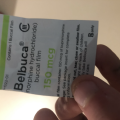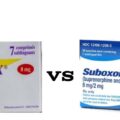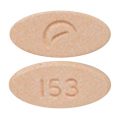The orange round pill with imprint AN 415 has been identified as Buprenorphine Hydrochloride and Naloxone Hydrochloride (Sublingual) 8 mg (base) / 2 mg (base). It is supplied by Amneal Pharmaceuticals. Buprenorphine/naloxone is used in the treatment of opiate dependence and belongs to the drug class narcotic analgesic combinations. Risk cannot be ruled out during pregnancy. Buprenorphine/naloxone 8 mg (base) / 2 mg (base) is classified as a Schedule 3 controlled substance under the Controlled Substance Act (CSA).
Method Of Administration
SUBOXONE sublingual film must be administered whole. Do not cut, chew, or swallow SUBOXONE sublingual film. Advise patients not to eat or drink anything until the film is completely dissolved.
Sublingual Administration
Place one film under the tongue, close to the base on the left or right side. If an additional film is necessary to achieve the prescribed dose, place an additional film sublingually on the opposite side from the first film. Place the film in a manner to minimize overlapping as much as possible. The film must be kept under the tongue until the film is completely dissolved. If a third film is necessary to achieve the prescribed dose, place it under the tongue on either side after the first 2 films have dissolved. SEE: How Long Does Suboxone Strips Stay In Your System
Buccal Administration
Place one film on the inside of the right or left cheek. If an additional film is necessary to achieve the prescribed dose, place an additional film on the inside of the opposite cheek. The film must be kept on the inside of the cheek until the film is completely dissolved. If a third film is necessary to achieve the prescribed dose, place it on the inside of the right or left cheek after the first two films have dissolved.
SUBOXONE sublingual film should NOT be moved after placement.
To ensure consistency in bioavailability, patients should follow the same manner of dosing with continued use of the product. Proper administration technique should be demonstrated to the patient.
Clinical Supervision
Treatment should be initiated with supervised administration, progressing to unsupervised administration as the patients clinical stability permits. SUBOXONE sublingual film is subject to diversion and abuse. When determining the prescription quantity for unsupervised administration, consider the patients level of stability, the security of his or her home situation, and other factors likely to affect the ability to manage supplies of take-home medication.
Ideally, patients should be seen at reasonable intervals (e.g., at least weekly during the first month of treatment) based upon the individual circumstances of the patient. Medication should be prescribed in consideration of the frequency of visits. Provision of multiple refills is not advised early in treatment or without appropriate patient follow-up visits. Periodic assessment is necessary to determine compliance with the dosing regimen, effectiveness of the treatment plan, and overall patient progress.
Once a stable dosage has been achieved and patient assessment (e.g., urine drug screening) does not indicate illicit drug use, less frequent follow-up visits may be appropriate. A once-monthly visit schedule may be reasonable for patients on a stable dosage of medication who are making progress toward their treatment objectives. Continuation or modification of pharmacotherapy should be based on the healthcare providers evaluation of treatment outcomes and objectives such as:
- Absence of medication toxicity.
- Absence of medical or behavioral adverse effects.
- Responsible handling of medications by the patient.
- Patients compliance with all elements of the treatment plan (including recovery-oriented activities, psychotherapy, and/or other psychosocial modalities).
- Abstinence from illicit drug use (including problematic alcohol and/or benzodiazepine use).
If treatment goals are not being achieved, the healthcare provider should re-evaluate the appropriateness of continuing the current treatment.
Unstable Patients
Healthcare providers will need to decide when they cannot appropriately provide further management for particular patients. For example, some patients may be abusing or dependent on various drugs, or unresponsive to psychosocial intervention such that the healthcare provider does not feel that he/she has the expertise to manage the patient. In such cases, the healthcare provider may want to assess whether to refer the patient to a specialist or more intensive behavioral treatment environment. Decisions should be based on a treatment plan established and agreed upon with the patient at the beginning of treatment. Patients who continue to misuse, abuse, or divert buprenorphine products or other opioids should be provided with, or referred to more intensive and structured treatment.
Discontinuing Treatment
The decision to discontinue therapy with SUBOXONE sublingual film after a period of maintenance should be made as part of a comprehensive treatment plan. Advise patients of the potential to relapse to illicit drug use following discontinuation of opioid agonist/partial agonist medication-assisted treatment. Taper patients to reduce the occurrence of opioid withdrawal signs and symptoms.
Switching Between Buprenorphine Or Buprenorphine And Naloxone Sublingual Tablets And SUBOXONE Sublingual Film
Patients being switched between buprenorphine and naloxone or buprenorphine only sublingual tablets and SUBOXONE sublingual film should be started on the same dosage of the previously administered product. However, dosage adjustments may be necessary when switching between buprenorphine products. Not all strengths and combinations of the SUBOXONE sublingual films are bioequivalent to SUBOXONE® sublingual tablets as observed in pharmacokinetic studies. Therefore, systemic exposures of buprenorphine and naloxone may be different when patients are switched from tablets to film or vice-versa. Patients should be monitored for symptoms related to over-dosing or under-dosing.
Switching Between SUBOXONE Sublingual Film Strengths
As indicated in Table 1, the sizes and the compositions of the four units of SUBOXONE sublingual films, i.e., 2 mg/0.5 mg, 4 mg/1 mg, 8 mg/2 mg and the 12 mg/3 mg units, are different from one another. If patients switch between various combinations of lower and higher strength units of SUBOXONE sublingual films to obtain the same total dose, (e.g., from three 4 mg/1 mg units to a single 12 mg/3 mg unit, or vice-versa), systemic exposures of buprenorphine and naloxone may be different and patients should be monitored for over-dosing or under-dosing. For this reason, pharmacist should not substitute one or more film strengths for another without approval of the prescriber.
Can You Snort An 415 Suboxone?
Stand alone buprenorphine can produce a fairly powerful high, especially if it’s crushed to be smoked or snorted, or dissolved into a solution to be injected. For this reason, Suboxone was designed to contain naloxone, a medication used in the treatment of opioid overdose. Naloxone blocks the opioid receptors in the brain so that any type of opioid will be rendered completely ineffective. Those suffering from an overdose can be saved by the quick application of this medication. In Suboxone, the naloxone is inactive as long as it remains in pill form. However, the act of crushing or dissolving the tablets activates the naloxone so the buprenorphine will not work. Considering the fact that abusing Suboxone in these ways is ineffective and likely to produce terrible withdrawal symptoms, it’s absolutely not worth it to attempt snorting, smoking, or injecting this drug. Doing so also suggests that the addiction treatment is not effective as drug abuse is still being attempted. READ: How To Spot Fake Suboxone Pills





